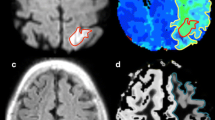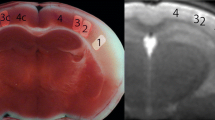Abstract
Objectives
To assess whether increases in amide proton transfer (APT)–weighted signal reflect the effects of tissue recovery from acidosis using transient rat middle cerebral artery occlusion (MCAO) models, compared to permanent occlusion models.
Materials and methods
Twenty-four rats with MCAO (17 transient and seven permanent occlusions) were prepared. APT-weighted signal (APTw), apparent diffusion coefficient (ADC), cerebral blood flow (CBF), and MR spectroscopy were evaluated at three stages in each group (occlusion, reperfusion/1 h post-occlusion, and 3 h post-reperfusion/4 h post-occlusion). Deficit areas showing 30% reduction to the contralateral side were measured. Temporal changes were compared with repeated measures of analysis of variance. Relationship between APTw and lactate concentration was calculated.
Results
Both APTw and CBF values increased and APTw deficit area reduced at reperfusion (largest p = .002) in transient occlusion models, but this was not demonstrated in permanent occlusion. No significant temporal change was demonstrated with ADC at reperfusion. APTw deficit area was between ADC and CBF deficit areas in transient occlusion model. APTw correlated with lactate concentration at occlusion (r = − 0.49, p = .04) and reperfusion (r = − 0.32, p = .02).
Conclusions
APTw values increased after reperfusion and correlated with lactate content, which suggests that APT-weighted MRI could become a useful imaging technique to reflect tissue acidosis and its reversal.
Key Points
• APT-weighted signal increases in the tissue reperfusion, while remains stable in the permanent occlusion.
• APTw deficit area was between ADC and CBF deficit areas in transient occlusion model, possibly demonstrating metabolic penumbra.
• APTw correlated with lactate concentration during ischemia and reperfusion, indicating tissue acidosis.




Similar content being viewed by others
Abbreviations
- ADC:
-
Apparent diffusion coefficient
- APTw:
-
Amide proton transfer–weighted signal
- CBF:
-
Cerebral blood flow
- MCAO:
-
Middle cerebral artery occlusion
References
Chesler M (2003) Regulation and modulation of pH in the brain. Physiol Rev 83:1183–1221
Zhou J, Wilson DA, Sun PZ, Klaus JA, Van Zijl PC (2004) Quantitative description of proton exchange processes between water and endogenous and exogenous agents for WEX, CEST, and APT experiments. Magn Reson Med 51:945–952
Zhou JY, Payen JF, Wilson DA, Traystman RJ, van Zijl PC (2003) Using the amide proton signals of intracellular proteins and peptides to detect pH effects in MRI. Nat Med 9:1085–1090
Sun PZ, Zhou J, Sun W, Huang J, van Zijl PC (2007) Detection of the ischemic penumbra using pH-weighted MRI. J Cereb Blood Flow Metab 27:1129–1136
Zheng Y, Wang XM (2017) Measurement of lactate content and amide proton transfer values in the basal ganglia of a neonatal piglet hypoxic-ischemic brain injury model using MRI. AJNR Am J Neuroradiol 38:827–834
Song G, Li C, Luo X et al (2017) Evolution of cerebral ischemia assessed by amide proton transfer-weighted MRI. Front Neurol 8:67
Zhou J, van Zijl PC (2011) Defining an acidosis-based ischemic penumbra from pH-weighted MRI. Transl Stroke Res 3:76–83
Heo HY, Zhang Y, Burton TM et al (2017) Improving the detection sensitivity of pH-weighted amide proton transfer MRI in acute stroke patients using extrapolated semisolid magnetization transfer reference signals. Magn Reson Med 78:871–880
Zong X, Wang P, Kim SG, Jin T (2014) Sensitivity and source of amine-proton exchange and amide-proton transfer magnetic resonance imaging in cerebral ischemia. Magn Reson Med 71:118–132
Sun PZ, Murata Y, Lu J, Wang X, Lo EH, Sorensen AG (2008) Relaxation-compensated fast multislice amide proton transfer (APT) imaging of acute ischemic stroke. Magn Reson Med 59:1175–1182
Sun PZ, Benner T, Kumar A, Sorensen AG (2008) Investigation of optimizing and translating pH-sensitive pulsed-chemical exchange saturation transfer (CEST) imaging to a 3T clinical scanner. Magn Reson Med 60:834–841
Sun PZ, Benner T, Copen WA, Sorensen AG (2010) Early experience of translating pH-weighted MRI to image human subjects at 3 tesla. Stroke 41:S147–S151
Campbell BC, Mitchell PJ, Kleinig TJ et al (2015) Endovascular therapy for ischemic stroke with perfusion-imaging selection. N Engl J Med 372:1009–1018
Jokivarsi KT, Hiltunen Y, Tuunanen PI, Kauppinen RA, Grohn OH (2010) Correlating tissue outcome with quantitative multiparametric MRI of acute cerebral ischemia in rats. J Cereb Blood Flow Metab 30:415–427
Dani KA, Warach S (2014) Metabolic imaging of ischemic stroke: the present and future. AJNR Am J Neuroradiol 35:S37–S43
Kidwell CS, Saver JL, Mattiello J et al (2000) Thrombolytic reversal of acute human cerebral ischemic injury shown by diffusion/perfusion magnetic resonance imaging. Ann Neurol 47:462–469
Weiss HR, Grayson J, Liu X, Barsoum S, Shah H, Chi OZ (2013) Cerebral ischemia and reperfusion increases the heterogeneity of local oxygen supply/consumption balance. Stroke 44:2553–2558
Tietze A, Blicher J, Mikkelsen IK et al (2014) Assessment of ischemic penumbra in patients with hyperacute stroke using amide proton transfer (APT) chemical exchange saturation transfer (CEST) MRI. NMR Biomed 27:163–174
Kilkenny C, Altman DG (2010) Improving bioscience research reporting: ARRIVE-ing at a solution. Lab Anim 44:377–378
Isayama K, Pitts LH, Nishimura MC (1991) Evaluation of 2,3,5-triphenyltetrazolium chloride staining to delineate rat brain infarcts. Stroke 22:1394–1398
Sun PZ, Farrar CT, Sorensen AG (2007) Correction for artifacts induced by B(0) and B(1) field inhomogeneities in pH-sensitive chemical exchange saturation transfer (CEST) imaging. Magn Reson Med 58:1207–1215
Guivel-Scharen V, Sinnwell T, Wolff SD, Balaban RS (1998) Detection of proton chemical exchange between metabolites and water in biological tissues. J Magn Reson 133:36–45
Keupp J, Baltes C, Harvey P, van den Brink J (2011) Parallel RF transmission based MRI technique for highly sensitive detection of amide proton transfer in the human brain at 3T. In: Proc Intl Soc Mag Reson Med 19
Maes F, Collignon A, Vandermeulen D, Marchal G, Suetens P (1997) Multimodality image registration by maximization of mutual information. IEEE Trans Med Imaging 16:187–198
Cox RW (1996) AFNI: software for analysis and visualization of functional magnetic resonance neuroimages. Comput Biomed Res 29:162–173
Zhang XY, Wang F, Jin T et al (2017) MR imaging of a novel NOE-mediated magnetization transfer with water in rat brain at 9.4 T. Magn Reson Med 78:588–597
Shen Q, Meng X, Fisher M, Sotak CH, Duong TQ (2003) Pixel-by-pixel spatiotemporal progression of focal ischemia derived using quantitative perfusion and diffusion imaging. J Cereb Blood Flow Metab 23:1479–1488
Leigh R, Knutsson L, Zhou J, van Zijl PC (2017) Imaging the physiological evolution of the ischemic penumbra in acute ischemic stroke. J Cereb Blood Flow Metab 38:1500–1516
Harada K, Honmou O, Liu H, Bando M, Houkin K, Kocsis JD (2007) Magnetic resonance lactate and lipid signals in rat brain after middle cerebral artery occlusion model. Brain Res 1134:206–213
Orlowski P, Chappell M, Park CS, Grau V, Payne S (2011) Modelling of pH dynamics in brain cells after stroke. Interface Focus 1:408–416
Lee D, Zhao X, Heo H, Zhang Y, Jiang S, Zhou J (2016) Dynamic changes of amide proton transfer (APT) and multi-parametric MR signals in transient focal ischemia in rats. In: Proc 24th Annual Meeting ISMRM Singapore
An HY, Ford AL, Chen YS et al (2015) Defining the ischemic penumbra using magnetic resonance oxygen metabolic index. Stroke 46:982–988
Pan J, Konstas AA, Bateman B, Ortolano GA, Pile-Spellman J (2007) Reperfusion injury following cerebral ischemia: pathophysiology, MR imaging, and potential therapies. Neuroradiology 49:93–102
Bivard A, Krishnamurthy V, Stanwell P et al (2014) Spectroscopy of reperfused tissue after stroke reveals heightened metabolism in patients with good clinical outcomes. J Cereb Blood Flow Metab 34:1944–1950
Wey HY, Desai VR, Duong TQ (2013) A review of current imaging methods used in stroke research. Neurol Res 35:1092–1102
Obrenovitch TP (1995) The ischaemic penumbra: twenty years on. Cerebrovasc Brain Metab Rev 7:297–323
Thornton JS, Ordidge RJ, Penrice J et al (1998) Temporal and anatomical variations of brain water apparent diffusion coefficient in perinatal cerebral hypoxic-ischemic injury: relationships to cerebral energy metabolism. Magn Reson Med 39:920–927
Xue R, Sawada M, Goto S et al (2001) Rapid three-dimensional diffusion MRI facilitates the study of acute stroke in mice. Magn Reson Med 46:183–188
Dijkhuizen RM, Knollema S, van der Worp HB et al (1998) Dynamics of cerebral tissue injury and perfusion after temporary hypoxia-ischemia in the rat: evidence for region-specific sensitivity and delayed damage. Stroke 29:695–704
Yamasaki F, Takaba J, Ohtaki M et al (2005) Detection and differentiation of lactate and lipids by single-voxel proton MR spectroscopy. Neurosurg Rev 28:267–277
Heo HY, Zhang Y, Lee DH, Hong X, Zhou J (2016) Quantitative assessment of amide proton transfer (APT) and nuclear overhauser enhancement (NOE) imaging with extrapolated semi-solid magnetization transfer reference (EMR) signals: application to a rat glioma model at 4.7 tesla. Magn Reson Med 75:137–149
Heo HY, Zhang Y, Jiang S, Lee DH, Zhou J (2016) Quantitative assessment of amide proton transfer (APT) and nuclear overhauser enhancement (NOE) imaging with extrapolated semisolid magnetization transfer reference (EMR) signals: II. Comparison of three EMR models and application to human brain glioma at 3 tesla. Magn Reson Med 75:1630–1639
Dula AN, Smith SA, Gore JC (2013) Application of chemical exchange saturation transfer (CEST) MRI for endogenous contrast at 7 tesla. J Neuroimaging 23:526–532
Funding
This study was supported by a grant (2016-690) from the Asan Institute for Life Sciences, Asan Medical Center, Seoul, Korea.
Author information
Authors and Affiliations
Corresponding author
Ethics declarations
Guarantor
The scientific guarantor of this publication is Dong Cheol Woo.
Conflict of interest
The authors of this manuscript declare no relationships with any companies whose products or services may be related to the subject matter of the article.
Statistics and biometry
We thank Seon Ok Kim for his expertise in statistical analysis.
Informed consent
Approval from the institutional animal care committee was obtained.
Ethical approval
This study was approved by the Institutional Animal Care and Use Committee of Asan Medical Center.
Methodology
• retrospective
• cross-sectional
• performed at one institution
Additional information
Publisher’s Note
Springer Nature remains neutral with regard to jurisdictional claims in published maps and institutional affiliations.
Electronic supplementary material
ESM 1
(DOCX 19 kb)
Rights and permissions
About this article
Cite this article
Park, J.E., Jung, S.C., Kim, H.S. et al. Amide proton transfer–weighted MRI can detect tissue acidosis and monitor recovery in a transient middle cerebral artery occlusion model compared with a permanent occlusion model in rats. Eur Radiol 29, 4096–4104 (2019). https://doi.org/10.1007/s00330-018-5964-3
Received:
Revised:
Accepted:
Published:
Issue Date:
DOI: https://doi.org/10.1007/s00330-018-5964-3




